I subscribe and read Garden Rant, a blog by a trio of women whose opinions are interesting and usually evoke a lot of discussion.
Recently the blog posted '10 Reasons to Hate Houseplants'. There was some thoughtful discussion. I've never had a tremendous amount of luck with houseplants -- mainly because I do not have enough south-facing windows or space to put them.
I must admit, I'm more fond of getting outside and gardening there rather than being inside tending to plants. I am one whose home does not lend itself well to keeping houseplants. I wish it did. I think I would grow more fond of them. Furthermore, I just plain forget to water them. It sounds ridiculous, especially when I am in the same room with them 50% of the time I'm home.
In fact, in the last few weeks, I think I managed to kill a fern because 1)our home is too mild and 2) again, I forgot to water the durn thing.
Good luck with your houseplants! And Happy Holidays!
Tuesday, December 19, 2006
Friday, December 15, 2006
Oh Christmas Tree
I'm not here to argue what's better - a real or a fake Christmas tree. I certainly see the convenience and money savings (depending on what you buy) of a fake tree. But as I was looking at our puny, little, yet nicely decorated fake tree the other evening, I thought that this Christmas would be the last time I bring that durn thing out to decorate.
Most of us can remember the trip to the Christmas tree lot or the woods to pick out the 'best' tree to take back to our homes. It was a family affair that I can still remember (and I don't have the best memory). I also remember the one time we went out on my great-grandparents farm and cut an old white pine to bring in for my elderly kin.
It was GREAT! And if it was snowing, that was even better! And so what if it was lopsided -- that's part of it! 2007 will be my year of the return to the REAL Christmas tree.
For more information on using cut or live trees in your home, go to the National Christmas Tree Association.
Most of us can remember the trip to the Christmas tree lot or the woods to pick out the 'best' tree to take back to our homes. It was a family affair that I can still remember (and I don't have the best memory). I also remember the one time we went out on my great-grandparents farm and cut an old white pine to bring in for my elderly kin.
It was GREAT! And if it was snowing, that was even better! And so what if it was lopsided -- that's part of it! 2007 will be my year of the return to the REAL Christmas tree.
For more information on using cut or live trees in your home, go to the National Christmas Tree Association.
Thursday, November 16, 2006
So many trees/shrubs, so little room to plant them all
While teaching a class on uncommon trees/shrubs that have a place in any home landscape, it was very tough to narrow down the list to what could be talked about in an hour and a half. Very difficult.
If I had a whole day, there would still be ones left out. So here's a quick list of some that are absolutely outstanding!
1. A biased #1 -- I absolutely love this plant -- Sourwood (Oxydendrum arboreum)

2. Beautyberry (Callicarpa spp.)
3. Bald cypress (Taxodium distichum)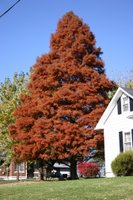
4. Kousa dogwood (Cornus kousa) or hybrids with our native dogwood (C. kousa x C. florida)
5. Deciduous hollies (Ilex decidua or I. verticillata)
6. Fringetree (Chionanthus virginicus)
7. Bottlebrush buckeye (Aesculus parviflora)
8. Blackgum (Nyssa sylvatica)
I'll stop there since my list would be very long if I tried to keep all the good ones on there. For a more comprehensive list, go to my website. It's a work in progress.
Please post your own favorites here. I'll warn you not to even mention ornamental pears or burning bushes -- they are not good plants...in my opinion...and overused to the point of being sickening.
If I had a whole day, there would still be ones left out. So here's a quick list of some that are absolutely outstanding!
1. A biased #1 -- I absolutely love this plant -- Sourwood (Oxydendrum arboreum)

2. Beautyberry (Callicarpa spp.)

3. Bald cypress (Taxodium distichum)

4. Kousa dogwood (Cornus kousa) or hybrids with our native dogwood (C. kousa x C. florida)
5. Deciduous hollies (Ilex decidua or I. verticillata)
6. Fringetree (Chionanthus virginicus)
7. Bottlebrush buckeye (Aesculus parviflora)
8. Blackgum (Nyssa sylvatica)
I'll stop there since my list would be very long if I tried to keep all the good ones on there. For a more comprehensive list, go to my website. It's a work in progress.
Please post your own favorites here. I'll warn you not to even mention ornamental pears or burning bushes -- they are not good plants...in my opinion...and overused to the point of being sickening.
Friday, November 03, 2006
A Good-looking Tree
When I came back to the office today, I told the secretary that I found a good-looking tree that I was leaving to take a picture of. She said 'Beth, you're old!'
If you don't believe me, take a look at this bald cypress (Taxodium distichum) that grows within a mile of our office. A deciduous conifer with rusty fall color. It'll only be a bit before the leaves fall off. Then you get to look at the great architecture of this plant.
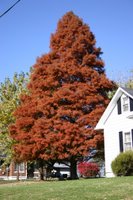
When you think of bald cypresses, you immediately think of the 'knees' when the plant is near water. This plant doesn't need a flooded root zone to live and thrive! It does perfectly fine in a regular ol' soil. You won't get any knees, though.
This is a plant worthy of much more planting. Check out more information here.
If you don't believe me, take a look at this bald cypress (Taxodium distichum) that grows within a mile of our office. A deciduous conifer with rusty fall color. It'll only be a bit before the leaves fall off. Then you get to look at the great architecture of this plant.

When you think of bald cypresses, you immediately think of the 'knees' when the plant is near water. This plant doesn't need a flooded root zone to live and thrive! It does perfectly fine in a regular ol' soil. You won't get any knees, though.
This is a plant worthy of much more planting. Check out more information here.
Monday, October 23, 2006
Colors of the Arboretum
Berheim Arboretum is a wonderful place. I would highly, highly encourage a visit. This time of year is especially rewarding with the colors and fruits of fall.
I took 71 pictures and should have taken 171.
A plain old hickory lights up an otherwise dark area.
Beautyberry (Callicarpa dichotoma 'Alba') berries can be white!
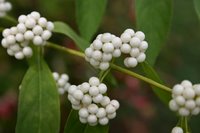
And a pine (Pinus densiflora 'Dragon Eye') may supposed to have yellow needles -- go figure.

Go to Bernheim!
I took 71 pictures and should have taken 171.
A plain old hickory lights up an otherwise dark area.
Beautyberry (Callicarpa dichotoma 'Alba') berries can be white!

And a pine (Pinus densiflora 'Dragon Eye') may supposed to have yellow needles -- go figure.

Go to Bernheim!
Monday, October 16, 2006
Are We Finally Done With Summer?
The freeze came. At home, on the morning of October 12, the temperature was 28 degrees. Most of the poke, pigweed, and ragweed got burned. But hyacinth bean iwll not recover. Nor will the sweetpotato vines here at the office. They are crispy. But the petunias lived.
The massive peppers near our entrance were saved by several night's lodgi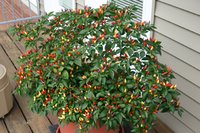 ng inside the office. They will look nice for a little longer -- or whenever I forget to drag them inside.
ng inside the office. They will look nice for a little longer -- or whenever I forget to drag them inside.
Waking up on Oct 12, it looked like a January morning. Everything was white with a thick frost. I couldn't imagine anything coming through but plants are amazing in their wills to live.
What do you think? Will we have another week or two with no frosts? I'm ambivalent. I'm already getting a little excited about looking through the new seed and plant catalogs for 2007.
The massive peppers near our entrance were saved by several night's lodgi
 ng inside the office. They will look nice for a little longer -- or whenever I forget to drag them inside.
ng inside the office. They will look nice for a little longer -- or whenever I forget to drag them inside.Waking up on Oct 12, it looked like a January morning. Everything was white with a thick frost. I couldn't imagine anything coming through but plants are amazing in their wills to live.
What do you think? Will we have another week or two with no frosts? I'm ambivalent. I'm already getting a little excited about looking through the new seed and plant catalogs for 2007.
Wednesday, October 04, 2006
Conspiracy Theory?
I was teaching the soils part of the Master Gardener Program here in Pulaski County yesterday. The class is a good one and asked a lot of good questions. We inevitably get sidetracked on to topics only related on the fringe.
The discussion was about fertilizers. And it turned to crabgrass control. UK recommends applying crabgrass control in late winter/early spring. Around here, that's March 15 or so. However, no fertilizer is recommended in the spring -- all fertilizers for turf should be applied in the fall and winter for our cool-season grasses.

Here's the buyer's beware: Just you try to find a crabgrass control product that has no fertilizer! It's dang near impossible! And it shouldn't be.
I'm not a conspiracy-minded person, but I truly believe that these chemical companies are in cahoots with lawn mower manufacturers. By putting fertilizer on legitimate spring crabgrass control, you are guaranteed to have to mow your lawn 2-3 times a week. Think about it. I don't think I'm that far off.
Here's another point. Several years ago, we were able to buy the crabgrass control only (with no fertilizer attached) from a dealer in Lexington KY. However, in 2005 this dealer did not carry the chemical by itself. The product they carried had 7% nitrogen! I asked them why? why? why?
The answer was that their lawn care guys (their customers) were demanding a crabgrass product WITH FERTILIZER! You make your own mind up. I have.
The picture above is 'Fireworks' goldenrod. A welcome splash of color this time of year.
Monday, October 02, 2006
Neglect is A Good Thing?
When it comes to composting, I used to be religious about turning the pile. That was BK -- Before Kids. Anyhow, these days, I rarely get to turn the pile. But over the weekend, my old 2X6 boards that I had been using to contain the pile, were retired and replaced with new ones.
And having not turned the pile in many, many months, the bottom of the pile was dark and rich. I actually got to harvest some humus -- considering my lack of aeration, I thought that was a great end result. The smell was earthy, the way it's supposed to be. You can't always get away without turning the compost pile, but I had dumped many different materials in the pile, some that were great for aeration (meaning -- sticks), so I guess I'm being rewarded for being neglectful.
I can live with that.
And having not turned the pile in many, many months, the bottom of the pile was dark and rich. I actually got to harvest some humus -- considering my lack of aeration, I thought that was a great end result. The smell was earthy, the way it's supposed to be. You can't always get away without turning the compost pile, but I had dumped many different materials in the pile, some that were great for aeration (meaning -- sticks), so I guess I'm being rewarded for being neglectful.
I can live with that.
Monday, September 18, 2006
A Few of My Favorite Things
Just a simple message today about being a good consumer. Disclaimer: UK does not endorse anything I'm about to say.
There are more choices out there in the tree and shrub world than what Lowe's (insert any big box store name here) offers for sale in its stores. There -- I said it. I can't stand Lowe's. I can't stand Walmart. You will never find me there -- except when I HAVE to buy my daughter a new dance outfit the VERY night she started her dance class and WM was the only choice at 8pm.
The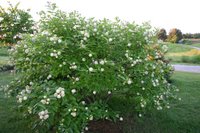 re are so many different, unique, beautiful, trees and shrubs in the world! And many of you end up buying Bradford pears, Taxus, dogwoods, just whatever might be in stock at the store.
re are so many different, unique, beautiful, trees and shrubs in the world! And many of you end up buying Bradford pears, Taxus, dogwoods, just whatever might be in stock at the store. 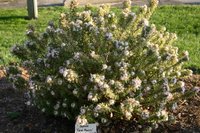
Well, let me name a few of my favorites and show you a few you're missing: Fringetree, Sourwood (below left), Kentucky Coffeetree, Blue ash, Bald Cypress, Daphne (at right), Contorted Filbert, Buttonbush (at left), Serviceberry, Bottlebrush buckeye, Beautyberry, Fothergilla, Kousa dogwood, purple redbuds, white redbuds, wee ping redbuds, red-leafed redbuds to name a few.
ping redbuds, red-leafed redbuds to name a few.
With the internet, we have no excuse for settling. Research your choices. Be a good consumer.
NC State University has a good website on various trees and shrubs with pictures.
There are more choices out there in the tree and shrub world than what Lowe's (insert any big box store name here) offers for sale in its stores. There -- I said it. I can't stand Lowe's. I can't stand Walmart. You will never find me there -- except when I HAVE to buy my daughter a new dance outfit the VERY night she started her dance class and WM was the only choice at 8pm.
The
 re are so many different, unique, beautiful, trees and shrubs in the world! And many of you end up buying Bradford pears, Taxus, dogwoods, just whatever might be in stock at the store.
re are so many different, unique, beautiful, trees and shrubs in the world! And many of you end up buying Bradford pears, Taxus, dogwoods, just whatever might be in stock at the store. 
Well, let me name a few of my favorites and show you a few you're missing: Fringetree, Sourwood (below left), Kentucky Coffeetree, Blue ash, Bald Cypress, Daphne (at right), Contorted Filbert, Buttonbush (at left), Serviceberry, Bottlebrush buckeye, Beautyberry, Fothergilla, Kousa dogwood, purple redbuds, white redbuds, wee
 ping redbuds, red-leafed redbuds to name a few.
ping redbuds, red-leafed redbuds to name a few.With the internet, we have no excuse for settling. Research your choices. Be a good consumer.
NC State University has a good website on various trees and shrubs with pictures.
Tuesday, September 12, 2006
More Plants but No Room
Every gardener has done this one -- buy plants with absolutely no place to put them. I do that much too often. Of course, when that happens you have to either stick them in a pot -- or -- cringe -- make a new bed.
It's not that I don't like making new beds in the garden. It's just that I have to de-sod bermudagrass. This is not fun. You can never remove all the bermuda. The best you can do is cut its head off (from which 3 new plants form, or course).
I made 2 new small beds over the weekend. Our yard has great soil. I planted some natives I got at the Salato Center's Native Plant Program semi-annual plant sale. I got boneset, Indian grass, New England asters, yellow coneflower, and my daughter picked out one catchfly (the bloom had faded to pink, she loves pink, and it was within arm's reach -- she was very proud, so I had to get it). These were planted on the south side of our house.
I also planted another native, Carolina Sweetshrub or Calycanthus fertilis. A plant here at the office had suckered so I dug it up. It lived, so I planted the little squirt on the north side of my house.

I also planted in the full-sun bed 2 seedling false blue indigo, Baptisia australis, (pictured at left) that I collected from around our plant here at the office.
So, come next year, I won't even remember the aching back and the sorry bermudagrass. Actually, I'll remember the bermuda since it will be in my new beds more than likely. Oh well, I'll enjoy the new plants up close while yanking out bermudagrass.
It's not that I don't like making new beds in the garden. It's just that I have to de-sod bermudagrass. This is not fun. You can never remove all the bermuda. The best you can do is cut its head off (from which 3 new plants form, or course).
I made 2 new small beds over the weekend. Our yard has great soil. I planted some natives I got at the Salato Center's Native Plant Program semi-annual plant sale. I got boneset, Indian grass, New England asters, yellow coneflower, and my daughter picked out one catchfly (the bloom had faded to pink, she loves pink, and it was within arm's reach -- she was very proud, so I had to get it). These were planted on the south side of our house.
I also planted another native, Carolina Sweetshrub or Calycanthus fertilis. A plant here at the office had suckered so I dug it up. It lived, so I planted the little squirt on the north side of my house.

I also planted in the full-sun bed 2 seedling false blue indigo, Baptisia australis, (pictured at left) that I collected from around our plant here at the office.
So, come next year, I won't even remember the aching back and the sorry bermudagrass. Actually, I'll remember the bermuda since it will be in my new beds more than likely. Oh well, I'll enjoy the new plants up close while yanking out bermudagrass.
Friday, September 08, 2006
Poor Souls
I have a box in the back of my truck that holds miscellaneous things I need in doing my job. Boots, pruners, wooden stakes, a couple of publications, measuring tape, etc. It was taken out of my truck in broad daylight yesterday as it sat in the parking lot of the Extension office.
I feel sorry for the poor souls that felt like they needed to take my stuff. Actually, it was all bought with taxpayer money, so the poor soul is costing Pulaski County residents, not me personally. There are a bunch of yard sales this weekend, so someone will probably end up buying the stuff.
I needed new pruners anyway.
I feel sorry for the poor souls that felt like they needed to take my stuff. Actually, it was all bought with taxpayer money, so the poor soul is costing Pulaski County residents, not me personally. There are a bunch of yard sales this weekend, so someone will probably end up buying the stuff.
I needed new pruners anyway.
Thursday, August 31, 2006
Worms Really Do Eat Garbage!
About 2 months ago, our office bought a worm bin, complete with worms and Mary Appelhof's book Worms Eat My Garbage. I've always liked worms -- you can ask my sister, who didn't share my enjoyment as a kid -- but never thought about cultivating them on a small scale.
Our worm bin sits outside our office and quietly, organic materials are digested. In 2 months time, I have deposited about 13 pounds of scraps. I've probably kept the worms on the lean side since I probably could have put twice that amount in the bin in those 2 months.
I compost at home, but those cold trips to the compost pile in January and February could be history if worms were in the basement. I could throw in all the dead crickets too.
Having this worm bin has really opened my eyes on how much work a small amount of worms can do. Just something to think about. Happy Labor Day everyone!
Our worm bin sits outside our office and quietly, organic materials are digested. In 2 months time, I have deposited about 13 pounds of scraps. I've probably kept the worms on the lean side since I probably could have put twice that amount in the bin in those 2 months.
I compost at home, but those cold trips to the compost pile in January and February could be history if worms were in the basement. I could throw in all the dead crickets too.
Having this worm bin has really opened my eyes on how much work a small amount of worms can do. Just something to think about. Happy Labor Day everyone!
Thursday, August 24, 2006
Know Your Plants!!!
I shouldn't, but I do get a little aggravated when someone has a problem with a plant and I ask what I think is a pretty simple, straight-forward question -- what's the name of the plant?
I think that if you care about the plants in your realm, you should have the wherewithall to find out what you have, what its requirements are, and then proceed to give it the care it needs. Of course, if you don't care, then just skip to the next post.
I had a visitor drop by the other day and ask 'Why isn't my lilac blooming?'. I ran down the list of the reasons why I thought. He said 'Just go out and take a look at it'. So I did.
He didn't have a lilac on site.
Not to ramble on, but I do think that knowing a scientific name every once in a while is not plant snobbery. It just shows you've taken the time to find out and that you care. If I hear 'Hy-geranium' one more time, I think I'll have to go prune something.....
I think that if you care about the plants in your realm, you should have the wherewithall to find out what you have, what its requirements are, and then proceed to give it the care it needs. Of course, if you don't care, then just skip to the next post.
I had a visitor drop by the other day and ask 'Why isn't my lilac blooming?'. I ran down the list of the reasons why I thought. He said 'Just go out and take a look at it'. So I did.
He didn't have a lilac on site.
Not to ramble on, but I do think that knowing a scientific name every once in a while is not plant snobbery. It just shows you've taken the time to find out and that you care. If I hear 'Hy-geranium' one more time, I think I'll have to go prune something.....
Thursday, August 17, 2006
Trees and Construction don't mix
More often than not, I am amazed by people -- around this area we have many people buying lake lots and proceed to build a new home. They intend to nestle this home among the large, old, mature trees and enjoy their new 'country life'.
A few years later, the trees die and they wonder if some disease or insect has killed them. Well, the disease is called bulldozer and backhoe disease (my term, not UK's). What amazes me about people is they don't realize that half the tree is under the soil. And this half is equally as important as the part they see above-ground. It may even be 'more equal' to quote another.
Plant roots need oxygen in order to survive. When a dozer makes hundreds of passes over a tree's root zone (which does not stop at the drip line), the soil is irreparably changed for the worse -- compacted, compacted, compacted. With no pore space for oxygen, the roots will die. When the roots die, the top starts dying back. The tree will eventually die.
If you claim to care about trees, think about the whole tree, not just the part that you can see.
A few years later, the trees die and they wonder if some disease or insect has killed them. Well, the disease is called bulldozer and backhoe disease (my term, not UK's). What amazes me about people is they don't realize that half the tree is under the soil. And this half is equally as important as the part they see above-ground. It may even be 'more equal' to quote another.
Plant roots need oxygen in order to survive. When a dozer makes hundreds of passes over a tree's root zone (which does not stop at the drip line), the soil is irreparably changed for the worse -- compacted, compacted, compacted. With no pore space for oxygen, the roots will die. When the roots die, the top starts dying back. The tree will eventually die.
If you claim to care about trees, think about the whole tree, not just the part that you can see.
Thursday, August 03, 2006
Mimosa
It doesn't matter how long you work in a certain field, there are always things to learn. I'm showing my ignorance, but today I had my first experience with Mimosa Wilt. This is a soil-borne disease which only affects mimosa trees.
Leaves will begin to yellow, wilt, and then drop off the tree. On the one I saw today, sap was oozing out of the tree where it made 2 foamy puddles at the base of the trunk. There was a definite fermenting odor, not pleasant-- and June bugs, yellow jackets, and flies were eating up the exuding sap.
When I got the call, my first reaction was 'someone actually wants one of these invasive plants to live?'. Most of the calls I get concerning mimosa are 'How do I kill it?'. I wasn't prepared. But come to find out, this disease is very common.
Maybe I've never gotten a call about this since anyone with an ailing mimosa tree wanted it to die anyway.
Leaves will begin to yellow, wilt, and then drop off the tree. On the one I saw today, sap was oozing out of the tree where it made 2 foamy puddles at the base of the trunk. There was a definite fermenting odor, not pleasant-- and June bugs, yellow jackets, and flies were eating up the exuding sap.
When I got the call, my first reaction was 'someone actually wants one of these invasive plants to live?'. Most of the calls I get concerning mimosa are 'How do I kill it?'. I wasn't prepared. But come to find out, this disease is very common.
Maybe I've never gotten a call about this since anyone with an ailing mimosa tree wanted it to die anyway.
Monday, July 31, 2006
June bugs and blackberries
At home, we have about 30 blackberry plants. We have really enjoyed picking and eating them right off the plant -- they are wonderful and sweet. But over the last 2 weeks, the June bugs and Japanese beetles have also been enjoying their sweetness.
I have found that our small black berry patch is the choice home for many, many mosquitoes and June bugs. As I go pick in the 90 degree weather, I wear long sleeves and long pants to deter mosquitoes -- but they usually find my uncovered neck and face to bite.
And the June bugs -- well, there's nothing you can wear to deter them. Maybe a suit of armor would be appropriate. They come flying out in their addled way, usually bumping into something (my head mostly). If one lands on the ground, the foot comes down on it. And you don't have to be quick, the poor lumbering souls are easy prey for the foot thing.
I have found that our small black berry patch is the choice home for many, many mosquitoes and June bugs. As I go pick in the 90 degree weather, I wear long sleeves and long pants to deter mosquitoes -- but they usually find my uncovered neck and face to bite.
And the June bugs -- well, there's nothing you can wear to deter them. Maybe a suit of armor would be appropriate. They come flying out in their addled way, usually bumping into something (my head mostly). If one lands on the ground, the foot comes down on it. And you don't have to be quick, the poor lumbering souls are easy prey for the foot thing.
Thursday, July 27, 2006
Black blotches on snap beans
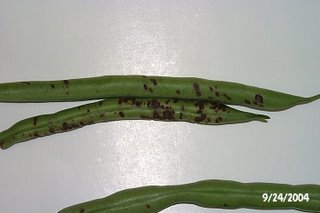
I've gotten a lot of calls about black blotches on snap beans, like white half runners. The culprit is probably anthracnose, a fungal disease.
What to do: most people don't want to eat things that look like this. Get the beans on a good spray schedule with chlorothalonil (Daconil or Funginil).
This disease is mostly seed-borne so be sure you start with clean seed.
First post - welcome
My name is Beth Wilson and I am the Horticulture Agent in Pulaski County KY. I work for the Pulaski County Cooperative Extension Service -- all Extension offices are affiliated with the University of Kentucky College of Agriculture.
This blog will be featuring different things as the growing season progresses. I might talk about common problems occurring in our plants or weird outbreaks of disease or insects. Or just whatever might be on my mind that day.
My goal is to make information readily available to those of you who might be interested in home gardening. We'll talk about favorite plants, least favorite plants, best times of the year to do things, and in general, how to be a successful home gardener in south central KY.
I want this to be fun and informative. Please post comments as you see fit.
This blog will be featuring different things as the growing season progresses. I might talk about common problems occurring in our plants or weird outbreaks of disease or insects. Or just whatever might be on my mind that day.
My goal is to make information readily available to those of you who might be interested in home gardening. We'll talk about favorite plants, least favorite plants, best times of the year to do things, and in general, how to be a successful home gardener in south central KY.
I want this to be fun and informative. Please post comments as you see fit.
Subscribe to:
Posts (Atom)

